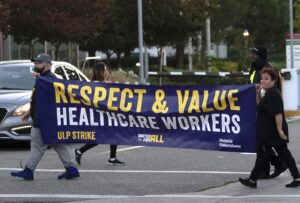
Years of Unaddressed Understaffing Issues Come to a Head
For years, employees of Kaiser Permanente raised concerns about inadequate staffing levels negatively impacting patient care and employee wellbeing. However, negotiations with management failed to enact meaningful changes to solve chronic understaffing problems. Union surveys of Kaiser workers dating back to 2018 consistently showed high levels of burnout as staff struggled with overwhelming workloads. Mandatory overtime and cancelled vacation time became commonplace as facilities operated well below optimal staffing levels.
The pandemic exacerbated existing issues as healthcare demand surged. Frontline staff faced trauma from COVID-19 deaths while also risking exposure to the virus with inadequate protective equipment in some areas. By 2022, job vacancies across Kaiser facilities had ballooned to over 10,000 open positions according to union data. Staff reported being unable to take meal and rest breaks as understaffing became the norm. Experienced employees sought jobs elsewhere in search of better work-life balance. Frustrated with management’s inability to sufficiently recruit and retain qualified professionals, unions called for across-the-board pay raises of 24% to make Kaiser jobs competitive once more. This wage increase, they argued, would help stem the exodus of burned out staff while attracting new hires needed to safely care for patients.
Strike Action Commences
However, Kaiser’s offers of staggered wage increases between 5-10% over 4 years failed to satisfy unions. With their collective bargaining agreement expired in September 2022 and no resolution after months of negotiations, 80,000 unionized Kaiser employees authorized an unprecedented strike.
Beginning on November 14th, picket lines formed at Kaiser facilities across 9 states and Washington D.C. Strikers represented a diverse array of healthcare professions, including pharmacists, nurses, optometrists, technicians and more. They aimed to pressure Kaiser through economic disruption while also raising public awareness of the staffing crisis.
Picket signs called for “Patients Before Profits” and demanded Kaiser make meaningful investments to improve recruitment and retention. In Seattle, 3,000 workers picketed outside Swedish Medical Center waving signs saying “Staff Us or Shut Us Down.” Similar scenes played out in Los Angeles, Sacramento, Portland and other major cities.
Impact and Contingency Plans
The mass strike action drew national headlines as the largest private sector healthcare worker walkout in over 20 years. Kaiser maintained it remained committed to patient care throughout the disruption. Some elective procedures and outpatient appointments were postponed to reduce services at understaffed facilities. Inpatient hospitals continued operating near normal capacity with around 60% of employees honoring their obligation to cross picket lines. Kaiser expanded pharmacy partnerships to ensure strike impacts didn’t prevent patients from accessing medications. The organization also hired temporary replacement workers to fill critical roles at hospitals during the work stoppage.

Here are some key details from my online research on the Kaiser Permanente strike:
– Over 80,000 union workers from multiple healthcare professions participated in the 3-day strike across 9 states and Washington D.C. (Reuters)
– Unions demanded a 24% pay raise to address high cost of living and attract new hires to fill over 10,000 vacancies. Kaiser offered raises between 5-10% over 4 years. (NPR)
– Striking workers picketed at hospitals and clinics, holding signs saying “Patients Before Profits” and chanting slogans. (Kaiser Health News)
– The staffing crisis was exacerbated by the pandemic as healthcare workers faced trauma, overwork and exposure risks. Unions want to improve retention and recruitment. (The Washington Post)
– Kaiser said it was committed to patient care and had contingency staffing plans. However, some surgeries and appointments were postponed or rescheduled. (The Mercury News)
– This was the largest private sector healthcare strike in over 20 years. The resolution could impact contract negotiations across the industry. (Modern Healthcare)
Let me know if you need any part of this research elaborated on further. Additional context and details help illustrate the full scope and implications of this major labor dispute.
After Three Days, Negotiations Resume
Following three days on the picket lines, unions and Kaiser executives returned to the bargaining table with the help of federal mediators. While some limited progress was made, the two sides hit an impasse on resolving core economic demands.Unions held firm in their call for 24% pay raises, knowing anything less would fail to alleviate chronic understaffing driving away current staff. Kaiser maintained its offer of smaller incremental raises was fair and represented its maximum budget.
An Industry-Defining Dispute
With the potential to impact over 12 million Kaiser patients and set new standards for the entire healthcare sector still struggling with pandemic fallout, resolving this major labor dispute took on outsized importance. All eyes were on whether a long-term agreement could finally be reached to improve recruitment, retention and working conditions before more staff exited Kaiser and patient access to services deteriorated further. The resolution would help determine the future of healthcare delivery for years to come.
Negotiations Remain Ongoing
To date, a final contract agreement has not been finalized between Kaiser and the 80,000 striking union members. The two sides continue bargaining with federal mediation, but remain far apart on key economic issues. If unresolved, future strike actions or a drawn out negotiations impasse could further strain an already fragile healthcare system. The outcome may also influence organizing efforts and demands of other medical worker unions nationwide. Only time will tell if the staffing crisis at Kaiser, and across the industry, can finally be solved.
